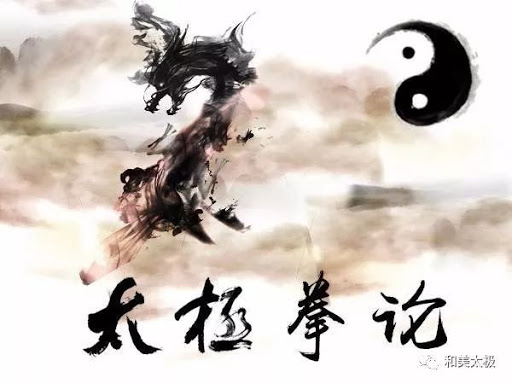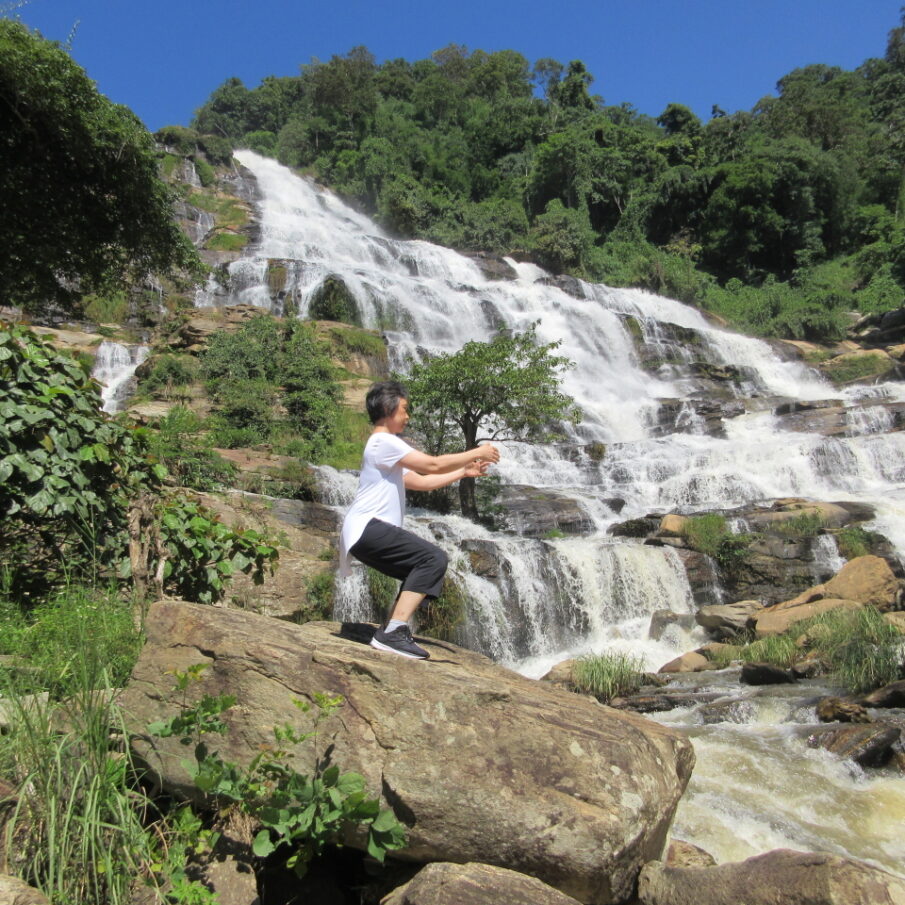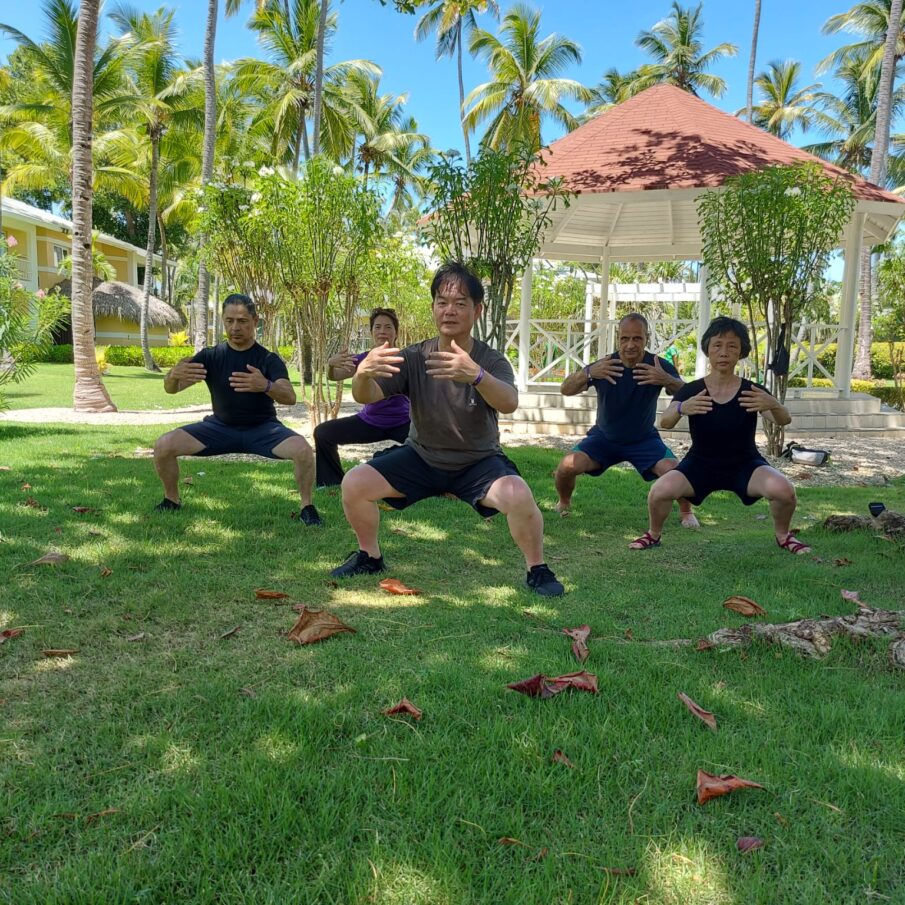
The second and third paragraphs from the treatise describe the Tai Chi learning stages and objectives. It is a good summary of the training goals. It helps to guide the student from a novice practitioner progressing all the way to a tai chi master.
Learning Stages
由著熟而漸悟懂勁,由懂勁而階及神明。然非用力之久,不能豁然貫通焉。
Learning is broadly categorized into 3 stages:
-
- Familiarity with the moves (著熟 Zhe shú)
- Feeling or knowing the energy (懂勁 Dǒng jìn)
- Spiritual illumination (神明 Shén míng)
1 – Familiarity with the moves (著熟 Zhe shú)
On its own, the first stage of learning will take a few years. To start, we must first learn all the moves in the form by knowing them intimately to be able to execute the entire form with fluency. In addition, we must understand the principles behind the movements and train ourselves to adhere to these principles at all times throughout the performance of the form. At this stage, these skills are still requirements related to the external movement competencies of tai chi. In other words, these skills are related to what we can easily witness visually when assessing our performance of the form.
2 – Feeling or knowing the energy (懂勁 Dǒng jìn)
The second stage of learning is what we classify as internal movement skills. The progression into the second stage is gradual. At this stage, students begin by paying attention to the pressure changes (energy or qì) within their body with each movement. It is only possible for someone to begin their journey into the second stage by slowing down their movements and focusing their attention inwards.
At this stage, the external movements are second nature to the student when they no longer need to think about which movement comes next or if they are performing the movement properly. Instead, their confidence in their external movement skills allows them to focus on the internal FEELING of the movement.
Of course, some moves are easier to feel than others. It will be natural during the early part of this stage of learning to have these feelings come and go. The amount of mental focus needed to remain aware of our internal movements can be exhausting. This is another reason why students may not be able to sustain this awareness throughout the entire form initially.
However, with practice as well as guidance from a tai chi master, the duration of this internal movement awareness increases. Students are guided as to how to experience these feelings to reduce their lapses in awareness. Eventually this mode of practice becomes natural where the student can feel every move.
Some people describe these feelings of internal movement as energy. In Yang and Wu style tai chi, this energy can feel wave-like. On the other hand, in Chen style tai chi, these internal movements have either a spiral or explosive feel.
3 – Spiritual illumination (神明 Shén míng)
The final stage is more difficult to define. Keep in mind that very few people ever reach this stage. At this point, what you think, how you feel, and what you do are now all synchronized. Every movement becomes easy and instinctive. There is no longer a struggle between what you want to do and what you are able to do.
At this stage, your body begins to relax so you feel at peace and your mind is clear as well as calm. These are not qualities of tai chi practice which can be consciously practiced to become accomplished at this third stage of learning. Instead it takes time and consistent practice for these qualities to slowly seep into your practice.
As you begin to enter this stage, there will be moments of clarity and peacefulness that may last a short time. And there will be some days when you will get it and other days when you just won’t. These are not qualities of their practice that students can actively seek to acquire. So, enjoy your practice and just allow this stage to come to you.
While attending a class and leaving all your worldly concerns behind to focus wholly on practicing tai chi may be a common definition of “meditation in motion”. Tai Chi Masters around the world would consider the accomplishment of this final stage of learning as the truly spiritual expression of “meditation in motion”.
Learning Objectives
Posture
虛領頂勁,氣沉丹田,不偏不倚,忽隱忽現。
The first part of the sentence is actually referring to the tai chi posture:
- Virtual Collar Lifting the Crown
- Sinking Qi to the Dantian
- No incline or leaning
- Qi disappearing and reappearing at will
First let us define some of the vocabulary used here:
Qì – when used in the context of tai chi, this word describes the pressure or force felt within the body. It is used interchangeably with the word energy at times.
Dantian – this is a point inside the body which is approximately 2 – 3 finger widths below the navel and towards the back of the torso. The literal translation of this Chinese word means “elixir field”.
Virtual Collar Lifting the Crown explains how to hold our head. Imagine wearing a high collar that makes your neck taller or longer. Next, imagine a string attached to the crown of your head pulling your head up even further. When the crown of the head is being pulled directly upwards, the chin will need to tuck inwards slightly.
Sinking Qi to the Dantian is a technique used to relax the body by sinking the energy or internal weight down to the lower abdomen.
The combination of the Virtual Collar Lifting the Crown and Sinking Qi to the Dantian will stretch and straighten the spine. While remaining centered over the hips without any incline or leaning of the torso, the tai chi practitioner achieves a proper postural alignment.
Finally, the posture of the tai chi practitioner includes having the qi disappearing and reappearing at will. The posture is held in a way that the qi appears hidden to others. However, the tai chi practitioner needs to be capable of drawing upon the qi to appear at will.
Movement
左重則左虛,右重則右杳。仰之則彌高,俯之則彌深。進之則愈長,退之則愈促。一羽不能加,蠅蟲不能落。人不知我,我獨知人。英雄所向無敵,蓋皆由此而及也。
The remaining paragraph needs to be explained in the context of tai chi push hands.
When the opponent applies weight on the left, then the left becomes empty. When the opponent applies weight on the right, then the right disappears.
Basically, in applying the yin and yang of movement to tai chi push hands, the main objective is not to try and meet the opponent head on. This is not as easy to accomplish as it sounds. Our first inclination is to push back when experiencing an opposing force. Look at the yin yang symbol, you will see this movement expressed visually. When the yin side flows into the one side of the circle, the yang half absorbs this change and shifts to fill the opposite side of the circle. As tai chi practitioners, we learn to do the same by emptying the side that is being attacked and redirecting or applying that weight or force to the opposite side to accomplish the yin yang of movement.
When the opponent goes up, respond by going higher. When the opponent goes down, react by going deeper. When the opponent advances, go even farther. When the opponent retreats, be even closer.
In fact, we do not just empty the side where the opponent attacks. We purposely lead the opponent to go even farther than they intended into that side. This is how we lure the opponent into our space. This is when the opponent makes mistakes which will cause them to lose their balance.
A single feather cannot be added to it and a fly cannot land on it. My opponent does not know me, I alone know him. A real hero has no opponent and all tai ji quan comes from this thought.
This describes the sensitivity of the tai chi master. The tai chi master has the ability to sense even the slightest change in weight and pressure. With this ability, it will appear as if you know your opponent’s every move while hiding your own intentions. When training in this manner, there really is no opponent. You are merely following the principles of tai chi and allowing your opponent to unbalance themselves.
Learning the Posture and Movement of Tai Chi
We have classes and programs at each level of learning tai chi. It starts at the Tai Chi Basics class where we provide a grounding of tai chi movements and vocabulary so the student can choose to move on to one of the two most popular forms: Yang or Chen style tai chi. At some point, more advanced classes such as Cannon Fist, Wu Style or Push Hands can be added to enhance experiencing internal movement concepts.
Next month, we will cover the third and final blog explaining the Taijiquan Treatise.



